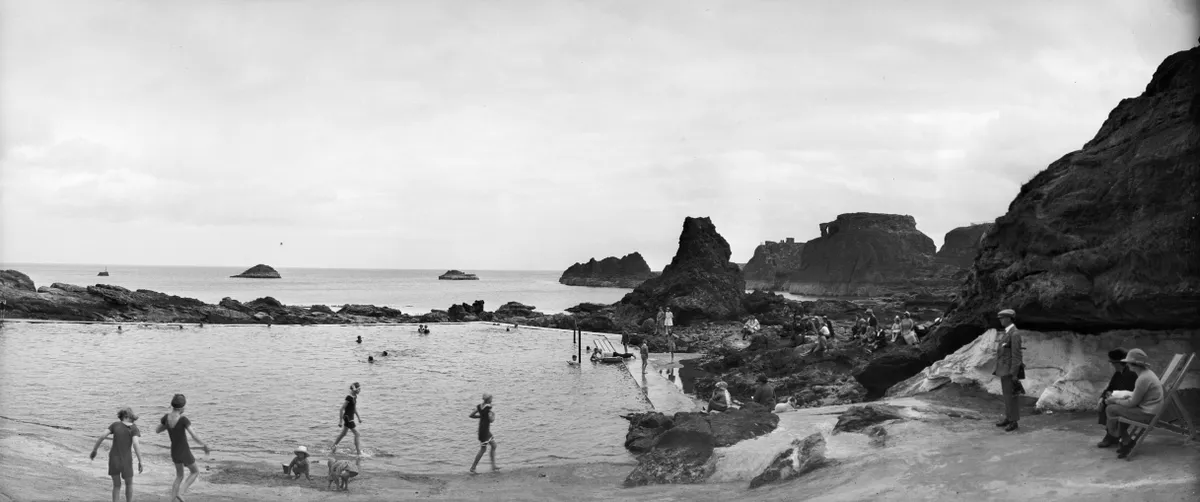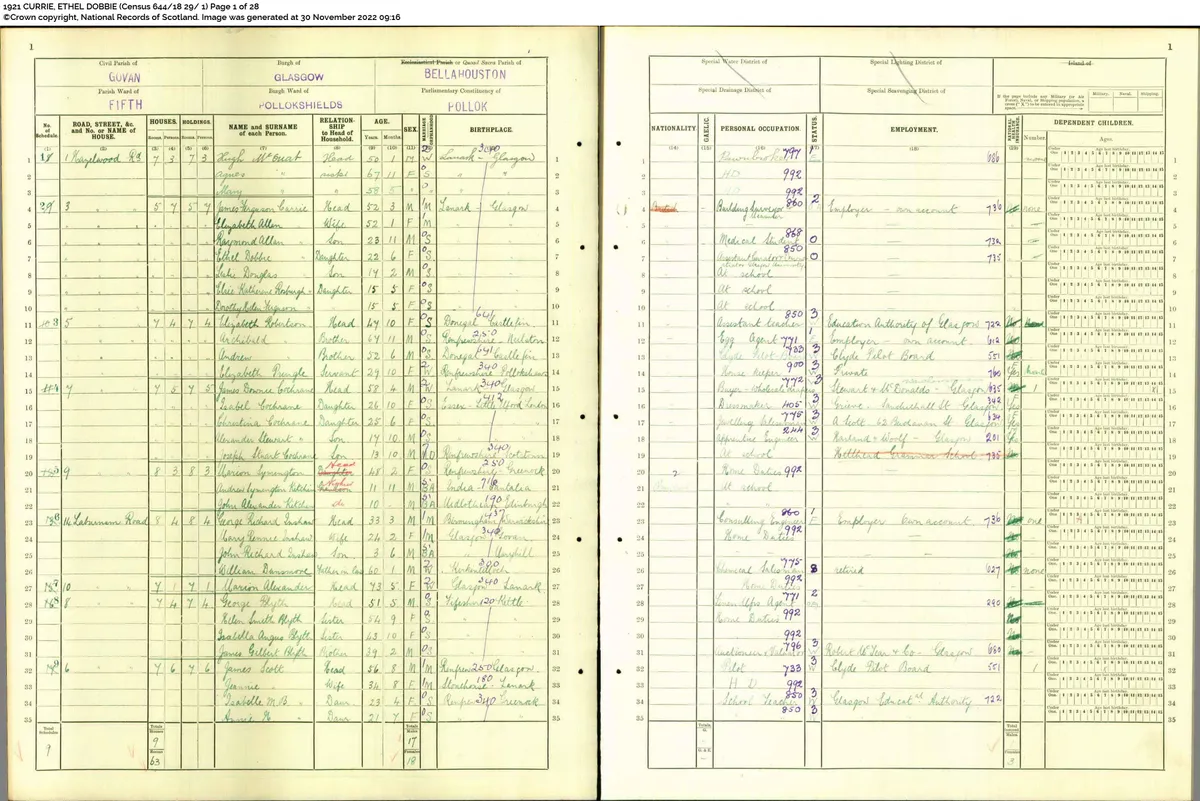When was the 1921 census for Scotland released?
The 1921 census for Scotland was released on 30 November 2022. Under data protection laws, census records can be released to the public 100 years after the census was carried out. The 1921 census for Scotland was originally scheduled to be released in June 2021, but the release was delayed by a year due to the coronavirus pandemic. The 1921 census for England and Wales was released on 6 January 2022 and is available on Findmypast.
How to access the 1921 census for Scotland
The 1921 census for Scotland is available on ScotlandsPeople, the Scottish government records website. The price of the Scottish 1921 census is £1.50 per page (6 credits), the same as other census records on ScotlandsPeople. As with other ScotlandsPeople records this will be on a pay-as-you-go basis using the same credit system that is in place for other census records on the website. Credits are available in bundles, starting with 30 credits for £7.50.
How to access the 1921 census for Scotland for free
You can access the 1921 census for Scotland at the ScotlandsPeople Centre in Edinburgh and the five other sites across Scotland that offer access to the ScotlandsPeople Centre search system: the Burns Monument Centre in Kilmarnock, the Clackmannanshire Family History Centre in Alloa, the Heritage Hub in Hawick, the Highland Archives Family History Room in Inverness and the Mitchell Library in Glasgow. Visits have to be booked in advance and cost £15, but you don't have to use credits to view the records, so it's worth doing if you have a lot of records you want to look at.
When was the 1921 census for Scotland taken?
The 1921 census of Scotland was taken on Sunday 19 June, 1921.
What questions were asked for the 1921 census of Scotland?
The 1921 census of Scotland asked people for:
- name and surname
- relationship to head of household
- age (in years and months)
- marital status
- orphanhood (for those under 15)
- place of birth
- nationality
- whether they spoke Gaelic and/or English
- occupation
- details of employment including name of employer
- whether entitled to National Insurance benefits
- number and age of children under 16
Background to the Scottish 1921 census by Myko Clelland
When considering the Scottish 1921 census, it’s easy to draw parallels with the modern Britain we live in. The world was coming out of a global pandemic in the form of the Spanish flu, the nation was beset by protests, civil and industrial strife, distrust in politicians was at an all-time high, and parts of the UK were on the brink of independence.
This similarity with today had roots in a changing and rapidly advancing world, one which thanks to the information given in earlier censuses, we are able to look back on with an enviable degree of clarity. This context we can give to the struggles and daily lives of our ancestors helps us understand them, their motives, and the Scotland they called home.

Census day itself was pushed back from the originally planned on 24 April due to widespread strikes that were planned on the 15th of the same month. The Scottish Union of Dock Labourers called a month long strike in sympathy with coal miners, who in the Miners’ Federation of Great Britain, the National Union of Railwaymen and the National Transport Workers’ Federation planned to take to the streets against wage reductions in a new post-war depression. This led to the government declaring a state of emergency, which included the moving of the enumeration of the country to 19 June.
For family historians, this matters. A census is a frozen point in time rather than a recording of what usually happened, and holding a census in the summer can lead to the population not being at their usual homes (as indeed many had already taken to the coast, to enjoy holidays). Be prepared to look for your relatives further afield than you may have found them otherwise. The population of Buteshire in particular, a county known for being the home of a number of popular tourist destinations, was noted to have increased by over 260% in some areas.

To a fair extent, the Scottish census looks very much like the one taken in the rest of Britain (there was no census in Ireland at the time owing to the Irish War of Independence). You’ll notice that those wonderful questions from 1911 that give you a length of marriage for couples, and the number of children born (both still alive and sadly passed) are now no longer present.
This loss is counterbalanced by some new information that you may have already come across in the southern counterpart that give an unprecedented window into working life for a genealogist. We’ll see not just what somebody did for a living, but who they worked for, and the address of that workplace. For those under 15, we’ll also see if either or both of their parents are deceased.
In Scotland there were additional questions about whether each person (over three years) spoke Gaelic only and also whether they were entitled to benefits under the National Insurance (Health) Acts.
The census is a once in a decade affair, and with what felt to many like the world falling apart around them, many took advantage of this rare opportunity to have their feelings heard. It’s certainly not unique for enumerators to find messages left for those in power in census returns, some whimsical, some moving, all giving a window into the lives of those heads of each household who filled in these forms. Even without these additional comments, there’s something powerful about seeing the original handwriting and signature of our ancestors.
In Scotland, when the census was tabulated, these returns were destroyed. All of those comments, every stroke of our ancestors’ hand, is gone. The records we will have access to will be scanned copies of the books that enumerators copied the information provided to them into. We can still learn the same facts, but we have certainly lost an incalculable amount of personality and social commentary.

What did the 1921 census of Scotland reveal?
Upon tabulation, the statistics gleaned give us a great view of a changing Scotland. The population was still growing as it has at each census, reaching 4,882,288 (an increase of 121,384, or 2.5%), and now triple the number that it stood at upon the eve of the first national census in 1801. This increase was however, the smallest to date by far. We can lay the blame for that upon the era of mass migration allowing greater numbers of Scots to leave their home for new lives across the globe, and of course on the aftermath of the tragic loss brought about by the First World War.
There is strong debate about the actual number of those who perished in the Great War (with estimates varying from 100,000 to up to 150,000), but the figures discussed show that Scotland suffered disproportionately to other nations in the conflict. Of the Scots who marched away to fight, around 25% did not come home: this is over double the percentage for the rest of the UK and Ireland of 11.8%. Only Serbia and the Ottoman Empire had a higher proportion of participant deaths than Scotland. 1.6% of the adult male population of the rest of the UK and Ireland did not return, but for Scotland that depletion could stand as high as 3.1%.

Deeper, societal changes can be seen in the results of the 1921 census. An increasingly connected nation saw the number of people who could speak only in Gaelic continued a steady decline, reducing by almost half from 1911 to 1921 (from 18,400 to 10,314). 151,159 could speak both Gaelic and English, but this was also a markedly smaller figure than the previous decade, where 183,998 claimed proficiency.
Urbanisation of the Victorian era continued, but there was evidence that conditions were improving. The 1911 census tells us that about half of the population lived in either one or two-roomed houses (with a far higher figure in the central belt as you might expect). However, the number of people who occupied these houses lowered consistently over the decade, suggesting housing was improving by 1921.
The census is a backbone of family history research that offers us this ‘snapshot’ of life. A window into a point in time from a century ago that promises to answer so many questions that may have been left with us since the previous in 1911, no matter how much longer than our southern counterparts we north of the border have been waiting.
1931 census Scotland
There’s a little bit of a positive to having Scottish heritage when it comes to modern census records too. After these records are released, the next census of England and Wales won’t be with us until around 2052 (the 1931 census was destroyed by fire, and the 1941 census wasn’t taken due to the war). We Scots can eagerly await what new mysteries can be solved by the 1931 census, stored separately from that of England & Wales, surviving in storage, even now. Mark your calendars already, because in only ten years’ time, we’ll be the lucky ones that have a whole new set of census records to discover!
